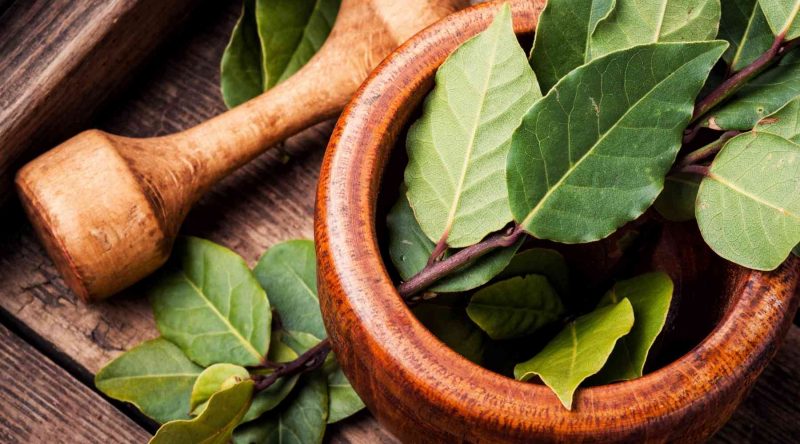Curry leaves are a staple in Indian dishes and are known to add freshness and a citrusy flavor to curries, rice dishes, meat and seafood, sauces and more. They come from the curry tree, which is a part of the citrus family. They are similar in taste to basil leaves and kaffir lime, and look like lemongrass. Curry leaves’ flavor changes once cooked, turning slightly bitter and nutty , but keeping their fresh aroma with citrus notes. They can also be boiled into teas.
Besides being used in cooking, these leaves are also used for medicinal purposes, since they have anti-inflammatory and anti-bacterial properties. Curry leaves boast incredible health benefits, like helping the body absorb iron, and taste great as well.
It is important to note the difference between fresh curry leaves versus powder. Curry leaves originate from Sri Lanka and parts of Southern Indian, whereas curry powder is a European spice made from cayenne, turmeric, and cumin. We will be focusing on only the leaves.
While curry leaves are an important component of many southeast Asian cuisines, sometimes you may not have any on hand, don’t want to use curry powder, and need to opt for a curry leaf substitute. Fortunately, there are several other options that will work as a good curry leaf substitute. Here we will discuss some various curry leaf replacements that taste just as good and mimic the same flavor as fresh curry leaves.
Best Curry Leave Substitutes
Lime Zest
Since curry leaves are known for their citrusy taste, replacing with lime zest from the lime’s rind just makes sense. By replacing curry leaves with zest, you can maintain the citrusy aroma, as well as the strong flavor. Add some chopped basil for extra minty flavor, and even a little lime juice to really round out the dish. Plus, just one zested lime is equal to replacing eight curry leaves.
Kaffir Lime Leaves
Otherwise known as makrut lime leaves, kaffir lime leaves have such a similar taste to curry leaves that they are perfect substitutes. Kaffir maintains the same citrus notes as curry leaves, and go great with curry dishes and stir fries.

Bay Leaves
Bay leaves are not as citrusy, but they do add an earthy flavor and minty aroma with sweet undertones that’s common in Indian cooking and Mediterranean cuisine, so they are a great replacement for curry leaves. Bay leaves are perfect for a variety of dishes, like stir fries and curries, as well as soups, stews, and even pesto sauce. You can even try Indonesian bay leaves for a deeper cinnamon flavor, especially in soups and stews. Plus, bay leaves have great health benefits, such as reducing cholesterol levels and helping to regulate glucose levels.
Keep in mind that a bay leaf can easily overpower a dish, so use just a single bay leaf per half cup of curry leaves.
Related: Arugula Substitutes
Lemon Zest
Similar to lime zest, lemon zest can also work as a substitute for curry leaves in a pinch. The lemon’s rind contains an oil that will give your dish a pungent aroma. Zest from a lemon can be used in fresh curry, as well as fish dishes, stir frying, and more.
Lemon Balm Leaves
Lemon balm leaves, part of the mint family, have a minty-fresh smell that is similar to curry leaves. Plus, it has the same citrus flavor. These leaves can be used in a variety of cooked dishes and all types of Indian cuisine. Because of their potency, it is best to use less lemon balm than curry leaves. For example, if a recipe calls for nine curry leaves, only use six lemon balm leaves, or two-thirds.
Not only does this herb work well for cooking, but it can also be used as a household remedy for digestive issues, like upset stomach and bad bloating. It is also known for its calming effects and helpfulness in promoting quality rest.
Lime Leaves
Although lime leaves aren’t as common as curry leaves, they still make a great substitute for curry leaves. They boast a beautiful subtle aroma, but pack a punch when it comes to your taste buds, so use them sparingly. These leaves are especially good in Asian dishes.
Make sure to prepare the leaves correctly before using. Before cooking, you’ll want to crush them up, slice them with a knife or some kitchen scissors, or let the leaves simmer well. You can use the same amount of these leaves as curry leaves for your recipes, so if a recipe calls for ten curry leaves, use ten lime.
Basil Leaves
Basil leaves are common in Mediterranean food and work extremely well as a substitute for curry leaves since they combine the flavors, aromas, and taste. To really bring out the flavor, add a bit of lemon juice or zest to your leaves, especially if you are using sweet basils. A basil leaf can be used at a one to one ratio with curry leaves.
Daun Salam Leaves
Although this herb is not as well-known, it still is a great way to replace curry leaves if needed. Daun salam leaves work great in meaty dishes and boast a sweet and spicy yet earthy taste, similar to cinnamon, but milder. These leaves work best in meats but are not a great option for vegetable dishes.
Related: Best Miso Substitutes
Curry Leaf Replacement Recipes
Easy Chicken Curry
Below is a simple recipe for chicken curry that includes the substitutes for curry leaves listed above.
Ingredients:
- 6 boneless chicken breasts cut into strips
- 1/4 cup olive oil
- 2 diced onions
- 1 tablespoon mustard seed
- 20 fresh curry leaves
- 10 fenugreek seeds
- 1 teaspoon salt
- 1 tablespoon garlic paste
- 1 tablespoon ginger paste
- 2 fresh green chilies – finely chopped
- 1 tablespoon cumin
- 1 tablespoon garam masala
- 400ml chopped tomatoes
- 1 tablespoon tomato paste
- Pinch of turmeric
- 1 bunch of coriander
- 400ml coconut milk
- 150ml double cream
- Pinch of spicy salt or plain salt and pepper
Chicken curry instructions:
- Make the sauce first.
- Pour the olive oil into a large pan over high heat, leaving one tablespoon behind.
- Once the oil is heated, add the mustard and fenugreek seeds and the curry leaves.
- When you notice the mustard seeds popping, add in the diced onions. Stir until caramelized – they should be light brown and soft.
- Add a dash of salt to release extra moisture from the onions.
- Once the onions are browned, add the garlic paste, ginger paste, and green chilies. Stir thoroughly.
- Wait one minute, then add the garam masala, cumin, and turmeric. Coat the vegetables with the spices.
- Add the tomatoes and tomato paste, and bring the dish to a simmer.
- Cut off the coriander stems and add to sauce.
- Pour in the coconut milk and cream and lightly stir before covering the sauce. Cook using low heat.
- With the leftover olive oil, fry the chicken until browned.
- After the chicken is almost cooked through, add it to the sauce and stir.
- Once the chicken is cooked through, sprinkle the curry with chopped coriander leaves. Add spicy salt or plain salt and pepper to taste to serve.
Curry leaf substitute ratios:
The above recipe calls for 20 curry leaves. Here is how that would look per the substitutes for curry leaves.
- Lime zest – use the zest of two and a half limes
- Kaffir lime leaves – 20 leaves – 1:1 ratio
- Bay leaves – 1/2 of a leaf – 1 leaf per half cup of curry leaves
- Lemon zest – use the zest of two and a half lemons
- Lemon balm – 13 leaves – 2/3 of the amount of curry leaves
- Lime leaves – 20 leaves – 1:1 ratio
- Basil leaves – 20 leaves – 1:1 ratio
- Daun salam leaves – 20 leaves – 1:1 ratio
Curried Beef Stew
Below is a simple recipe for curried beef stew that includes the substitutes for curry leaves listed above.
Ingredients:
- 3/4 pound beef stew meat
- 1/4 teaspoon salt
- 1/8 teaspoon pepper
- 2 tablespoons all-purpose flour
- 1 tablespoon olive oil
- 1 chopped onion
- 10 curry leaves
- 2 teaspoons soy sauce
- 3 cups beef stock
- 3 medium potatoes, cut into 1-inch cubes
- 2 thinly sliced carrots
- 1 tablespoon white vinegar
Curried beef stew instructions:
- Sprinkle the beef with the salt and pepper before tossing with all-purpose flour.
- In a Dutch oven or large pan, heat the olive oil over medium heat.
- Cook the beef and chopped onion until softly browned, lightly stirring.
- Stir in curry leaves, soy sauce, and beef stock before bringing to a boil.
- Reduce the heat and let simmer, covered for about 45 minutes.
- Stir in the potatoes and sliced carrots and return stew to a boil.
- Reduce the heat and let simmer, covered, until the meat and vegetables are tender. This takes about 1 to 1 hour and 20 minutes time. Stir stew occasionally.
- Lastly, stir in the vinegar. Optional to serve with hot brown rice.
Curry leaf substitute ratios:
The above recipe calls for 10 curry leaves. Here is how that would look per the substitutes for curry leaves.
- Lime zest – use the zest of one lime
- Kaffir lime leaves – 10 leaves – 1:1 ratio
- Bay leaves – 1/3 of a leaf – 1 leaf per half cup of curry leaves
- Lemon zest – use the zest of one lemon
- Lemon balm – 6 leaves – 2/3 of the amount of curry leaves
- Lime leaves – 10 leaves – 1:1 ratio
- Basil leaves – 10 leaves – 1:1 ratio
- Daun salam leaves – 10 leaves – 1:1 ratio
Replacing Curry Leaves in Recipes is Easy
With the multitude of options out there, it should be fairly simple to be able to replace curry leaves with any number of different ingredients. Keep in mind what foods you are cooking and flavors and aromas you are aiming for. Most Asian and Mediterranean dishes work best with more citrusy ingredients, like lime leaves, lime zest, or lemon zest. If you want more of a bitter twist for Indian foods or Italian dishes, it is best to opt for bay, basil, lemon balm, or daun salam leaves.
Almost all of these curry leaf replacements can be used in most dishes that call for curry leaves, like curries, soups, stews, broths, rice dishes, steamed meats, seafood, dals, ghee, and even some breads. If you want to replicate the pungent and strong flavor that curry leaves are known for, simply use one of these versatile alternatives and your dish will turn out just as good, if not better, than the original curry leaf recipe.
